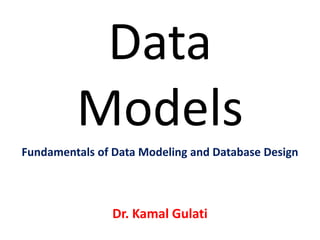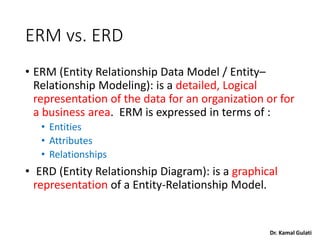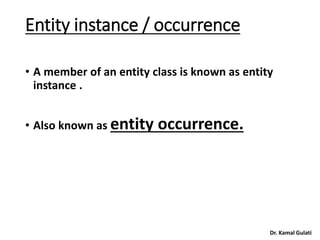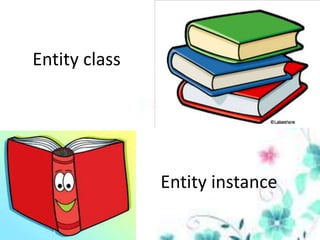Ad
Fundamentals of Data Modeling and Database Design by Dr. Kamal Gulati
- 1. Data Models Dr. Kamal Gulati Fundamentals of Data Modeling and Database Design
- 2. Dr. Kamal Gulati ERM vs. ERD • ERM (Entity Relationship Data Model / Entity– Relationship Modeling): is a detailed, Logical representation of the data for an organization or for a business area. ERM is expressed in terms of : • Entities • Attributes • Relationships • ERD (Entity Relationship Diagram): is a graphical representation of a Entity-Relationship Model.
- 3. Dr. Kamal Gulati ERM (Entity Relationship Modeling) • Is a data model for describing the data or information aspects of a business domain or its process requirements, in an abstract way that lends itself to ultimately being implemented in a database such as a relational database. • Data Model: A set of concepts to describe the structure of a database and certain constrain that the database shouldobey.
- 4. Dr. Kamal Gulati • The main components of ER models are entities (things) and the relationships that can exist among them. • Entity–Relationship Modeling was developed by Peter Chen and published in a 1976.
- 5. Dr. Kamal Gulati The three schema approach to software engineering uses three levels of ER models that may be developed. • Conceptual data model • Logical data model • Physical data model
- 7. Dr. Kamal Gulati Conceptual data model • A conceptual schema or conceptual data model is a map of concepts and their relationships used for databases. • This describes the semantics of an organization and represents a series of assertions about its nature. • Specifically, it describes the things of significance to an organization (entity classes), about which it is inclined to collect information, and characteristics of (attributes) and associations between pairs of those things of significance (relationships).
- 8. Dr. Kamal Gulati CONCEPTUAL DATA MODEL • This ER model establishes a broad view of what should be included in the model set. Conceptual data models: • Include important entities and the relationship between them. • Do not specify attributes. • Do not specify primary keys. • Conceptual ERDs can be used as the foundation for logical data models. They may also be used to form commonality relationships between ER models as a basis for data model integration.
- 9. Dr. Kamal Gulati Logical data model • Is a type of data model showing a detailed representation of an organization's data, independent of any particular technology, and described in business language. • A logical data model standardizes people, places, things and the rules, relationships and the events between them.
- 10. Dr. Kamal Gulati LOGICAL DATA MODEL • This model contains more detail than the conceptual ER model, without regard to how information will be physically implemented in the database. Logical data models: • Include all entities and relationships between them. • Specify attributes for each entity. • Specify primary key for each entity. • Specify foreign keys, which identify the relationship between different entities. • Involve normalization, which is the process of removing redundancy in a table so that the table is easier to modify. Normalization typically occurs by dividing an entity table into two or more tables and defining relationships between the tables.
- 11. Dr. Kamal Gulati Physical data model • A physical data model (or database design) is a representation of a data design which takes into account the facilities and constraints of a given database management system. • In the lifecycle of a project it typically derives from a logical data model, though it may be reverse- engineered from a given database implementation.
- 12. Dr. Kamal Gulati PHYSICAL DATA MODEL • The physical data model represents the process of adding information to the database. This model shows all table structures, including column name, column data type, column constraints, primary key, foreign key, and relationships between tables. Physical data models: • Specify all tables and columns. • Include foreign keys to identify relationships between tables. • May include denormalization, depending on user requirements. • May be significantly different from the logical data model. • Will differ depending on which DBMS (database management system) is used.
- 13. Dr. Kamal Gulati Conceptual Data Model (CDM) Logical Data Model (LDM) Physical Data Model (PDM) Includes high-level data constructs Includes entities (tables), attributes (columns/fields) and relationships (keys) Includes tables, columns, keys, data types, validation rules, database triggers, stored procedures, domains, and access constraints Non-technical names, so that executives and managers at all levels can understand the data basis of Architectural Description Uses business names for entities & attributes Uses more defined and less generic specific names for tables and columns, such as abbreviated column names, limited by the database management system (DBMS) and any company defined standards Uses general high-level data constructs from which Architectural Descriptions are created in non-technical terms Is independent of technology (platform, DBMS) Includes primary keys, also all other keys and indices for fast data access. May not be normalized Is normalized to fourth normal form (4NF) May be de-normalized to meet performance requirements based on the nature of the database. If the nature of the database is Online Transaction Processing (OLTP) or Operational Data Store (ODS) it is usually not de- normalized. De-normalization is common in Data warehouses.
- 14. Dr. Kamal Gulati
- 15. Dr. Kamal Gulati ERD (Entity Relationship Diagram) • Logical representation of data in an organization. • Views the entire system as a collection of entities related to one another.
- 16. Dr. Kamal Gulati Advantages of E-R Model
- 17. Dr. Kamal Gulati Elements of E-R Diagram • 1: Entity • 2: Attributes • 3: Relationships
- 18. Dr. Kamal Gulati
- 19. Dr. Kamal Gulati
- 20. Dr. Kamal Gulati Entity • An Entity is a Person, Place, Thing or Event for which data is collected and maintained. • Entities are represented in ER diagrams by a rectangle and named using singular nouns. Entity namesymbol
- 21. Dr. Kamal Gulati Entity type/Entity class • A set of entities with same attributes • Example: • Student entity class is a set of all students. • Book entity type is for all Books etc.
- 22. Dr. Kamal Gulati Entity instance / occurrence • A member of an entity class is known as entity instance . • Also known as entity occurrence.
- 23. Dr. Kamal Gulati Entity Class Entity instance
- 24. Dr. Kamal Gulati Entity class Entity instance
- 25. Dr. Kamal Gulati Weak Entity • A weak entity is an entity that depends on the existence of another entity. • In more technical terms it can defined as an entity that cannot be identified by its own attributes. • It uses a foreign key combined with its attributed to form the primary key. • An entity like order item is a good example for this. The order item will be meaningless without an order so it depends on the existence of order.
- 26. Dr. Kamal Gulati • Example: Name, address, Class and Email of a students are his attributes. • Can you define for Employee? Attribute name Symbol
- 27. Dr. Kamal Gulati
- 28. Dr. Kamal Gulati Attribute Domain: • A set of possible values for an attribute • All attributes have domain • Example : • The domain for Grade point average (GPA) can be from 0 to 4. • Similarly, domain for Gender attribute can be Either male or female.
- 29. Dr. Kamal Gulati Types of Attributes • 1: Simple • 2: Composite • 3: Single valued • 4: Multi-valued • 5: Derived
- 30. Dr. Kamal Gulati • Cannot be subdivided into smaller components. PERSON GENDER
- 31. Dr. Kamal Gulati • Can be divided into smaller components. EMPLOYEE ADDRESS street city country
- 32. Dr. Kamal Gulati Single-valued Attributes: Contain single valued value. Employee Gender Multi-valued Attributes: Contain two or more values. person name city hobbies
- 33. Dr. Kamal Gulati Multivalued Attribute • If an attribute can have more than one value it is called an multivalued attribute. • It is important to note that this is different to an attribute having its own attributes. • For example a teacher entity can have multiple subject values.
- 34. Dr. Kamal Gulati Derived Attribute • An attribute based on another attribute. This is found rarely in ER diagrams. • For example for a circle the area can be derived from the radius.
- 35. Dr. Kamal Gulati Relationship • A relationship describes how entities interact. For example, the entity “carpenter” may be related to the entity “table” by the relationship “builds” or “makes”. • Relationships are represented by diamond shapes and are labeled using verbs.
- 36. Dr. Kamal Gulati The number of entities in a relationship •Types: 1: Unary relationship 2: Binary relationship 3: Ternary relationship
- 37. Dr. Kamal Gulati Unary Relationship • It is also called as Recursive Relationship. • If the same entity participates more than once in a relationship it is known as a recursive relationship. • For E.g: An employee can be a supervisor and be supervised, so there is a recursive relationship.
- 38. Dr. Kamal Gulati
- 39. Dr. Kamal Gulati • Exist between the instances of two entity types. • Types: • 1: one-to-one • 2:one-to-many • 3:many –to-many
- 40. Dr. Kamal Gulati
- 41. Dr. Kamal Gulati
- 42. Dr. Kamal Gulati • The maximum number of relationships. *Circle means zero *Line means………..one *Crow’s foot symbol means….many
- 43. Dr. Kamal Gulati Relationship • Cardinality and Ordinality are two other notations used in ER diagrams to further define relationships. • Cardinality specifies how many instances of an entity relate to one instance of another entity. Cardinality specifies the maximum number of relationships and • Ordinality specifies the absolute minimum number of relationships. • For example, a “student” is not to required to “join” an “activity”. While an “activity” should be participated by many “student”.
- 44. Dr. Kamal Gulati Tips on How to Draw ER Diagrams 1. Identify all the relevant entities in a given system and determine the relationships among these entities. 2. An entity should appear only once in a particular diagram. 3. Provide a precise and appropriate name for each entity, attribute, and relationship in the diagram. 4. Remove vague, redundant or unnecessary relationships between entities. 5. Never connect a relationship to another relationship. 6. Make effective use of colors.
- 45. Dr. Kamal Gulati Proprietary ER diagramming tools • Avolution • Creately • ER/Studio • ERwin • DeZign for Databases • LucidChart • MagicDraw • MEGA International • ModelRight • Navicat Data Modeler • OmniGraffle • Oracle Designer • PowerDesigner • Prosa Structured Analysis Tool • Rational Rose • Software Ideas Modeler • Sparx Enterprise Architect • SQLyog • System Architect • Toad Data Modeler • Visual Paradigm • yEd • http://creately.com/ER-diagram-software
- 46. Dr. Kamal Gulati Exam database ERD
- 47. Dr. Kamal Gulati
- 48. Dr. Kamal Gulati Car Rental System
- 49. Dr. Kamal Gulati Hotel Reservation System
- 50. Dr. Kamal Gulati
- 51. Dr. Kamal Gulati Railway Reservation System
- 52. Dr. Kamal Gulati
- 53. Dr. Kamal Gulati Benefits of ER diagrams • ER diagrams constitute a very useful framework for creating and manipulating databases. • First, ER diagrams are easy to understand and do not require a person to undergo extensive training to be able to work with it efficiently and accurately. • Second, ER diagrams are readily translatable into relational tables which can be used to quickly build databases. In addition, ER diagrams can directly be used by database developers as the blueprint for implementing data in specific software applications. • Lastly, ER diagrams may be applied in other contexts such as describing the different relationships and operations within an organization.
- 54. Dr. Kamal Gulati
- 56. Dr. Kamal Gulati name DOB Phone no Project no Project name Project cost duration name Address Date of last meeting number
- 57. Dr. Kamal Gulati
- 58. Dr. Kamal Gulati
- 59. (Hope you are able to understand the Fundamentals of Data Modeling and Database Design) For More Questions / Queries Feel Free to Contact me.
- 60. Dr. Kamal Gulati Associate Professor | University Quality Support Head Mentoring Programme Coordinator & Exam Superintendent | [Ph. D., M.Sc. (Computer Science), M.C.A., M.B.A] Professional Certifications: • Certified Microsoft Innovative Educator • Data Science 101 Certification from Big Data University • R Language 101 Certification from Big Data University • SQL Certification from SOLOLEARN.com • Certified IBM Big Data 101 from Big Data University • R Program & Python Certified from DataCamp • Wiley Certified Big Data Analyst [WCBDA] • Certification on DBMS from IIT Mumbai • Certified Cisco Certified Network Associate [CCNA] • Certified Microsoft Certified Professional [MCP] • Certified Brainbench in (MS Access, MS Project, MySQL 5.7 Administration, Computer Fundamentals, Advanced Ms. Excel & Windows OS) • Real-time Advertising Fundamentals Certified from RTA Academy
- 61. • Worked as Visiting Professor with Stratford University, USA for six months from Jan’2016 to June’2016. • Also worked at Bahrain University in Kingdom of Bahrain Sr. I.T. Faculty (Computer Science Department) for Period of 2 Years. • Have rich experience in the field of teaching and research in Computer Science and Information Technology for almost 15+ years in Academia. • Having experience of working with both private and public institutions and universities as the lecturer and self-instruction material writer for Information Technology courses. • Had number of research papers published in national and international journals and conference proceedings in IEEE and Scopus Index. • Also chaired various National and International Conferences of repute and associated with various International Journals as Editorial Board Member for International and National, Academic Adviser and Research Paper Reviewer. • My current area of interest: Big Data Analytics, R Software, Internet & Web Technology, IT Project Management, Decision Support System, Business Analytics, Management Information System, Database Management System, Data Networking, R Software and Advanced Excel with Visual Basic Macros. • Country Visited: USA, Canada, UAE, Bahrain, Oman (Mostly for Teaching and Research Purpose) Profile of Dr. Kamal Gulati
- 62. Profile Contd…. • Technical Program Committee for International Conference on Data, Engineering and Applications 2017 (IDEA-2k17) which would be on October 28-29, 2017 at Bhopal. http://www.ideaconference.in • Advisory Board Committee Member for International Conference on Energy, Communication, Data Analytics and Soft Computing (ICECDS) which would be on 1-2 August 2017 at SKR Engineering College, Poonamallee, Tamil Nadu, India. http://ecds.org.in • Advisory Committee Member for International Conference on Innovative Research in Engineering and Science which would be on 16-17 June 2017 at Asian Institute of Technology Conference Center Thailand. http://www.iresconf.org • Advisory Committee Member for International Conference on Cloud Computing and Internet of everything which held on 10-11 Feb’2016 at Delhi-NCR. http://www.ccioet.org • Technical Committee member for InCITe-2016 (International Conference on Information Technology) Theme - Internet of Things: Connect Your Worlds, IT Summit, Amity University 2016 which held on 06-07 Oct, 2016. http://www.amity.edu/incite2016 • Technical Speaker for Global perspective on IT business “The Changing Scenario” – Big Data on International Students Conference New Delhi (ISCND) which held on 14-15 Oct, 2016 http://iscnd.com • Advisory Committee Member for International Conference on Sustainable Computing Techniques in Engineering, Science and Management which has held on 09-10 Sep’2016 at Delhi-NCR. http://www.scesm.org • Technical Program Committee Member for Program Committee Member for International Conference on Recent Trends IN ICT, Jaipur, India, Aug 18-19, 2017 http://rtict.org • Program Committee Member for International Conference on Recent Advancement in Computer and Communication Bhopal, India, (IC-RAC-2017) May 26-27, 2017 http://www.icrac.co.in
- 63. Profile Contd…. • Editorial Board member for the following International Journals: – International Journal of Computer Science and Innovation http://www.infinitysciences.org – International Journal of Latest Research in Engineering and Technology http://www.ijlret.com – International Journal of Latest Trends in Engineering and Technology http://www.ijltet.org – International Journal of Application or Innovation in Engineering & Management http://www.ijaiem.org – International Journal for Management http://www.ijm-apm.com – The International Journal of Emerging Engineering and Embedded Systems http://www.ijeees.org – Conference Info http://conferenceinfo.org/tpc.php • Expert Speaker for Program “Insurance Beyond Doubt” Presented by Oriental Insurance Co Ltd. https://www.youtube.com/watch?v=GrvJkN_Zn3Q
- 64. BOOK, CHAPTER, and CASE STUDY Published • Published Book on “A Study of Changing Trends in E-CRM of Indian Insurance Industry” Published by LAP Lambert Academic Publishing, one of the top researchers and renowned scientists of Germany with ISBN: 3330009543, 9783330009547. The Book available at Amazon.com. • Published Real Case Study on “IoT Security Considerations for Higher Education” published on Business Cases - RENVOI 2017 BOOK (The Case Centre, UK) with ISBN: 978-1-4828-8840-9, Page 63-70. The Book available at the various online website: Amazon, AbeBooks, Chegg, Barnes & Noble. • Published Chapter on "Role of eWorld in Insurance Innovation" Published by Insurance Institute of India (III), 60 Years Diamond Jubilee, Compendium, Nov 2016 – (Magazine) – One of the premium Insurance Institute of India.
- 65. Contact Details • Email : [email protected] • Website : http://mybigdataanalytics.com • LinkedIn : https://in.linkedin.com/in/drkamalgulati • Phone: +91-9718361928




























































![Dr. Kamal Gulati
Associate Professor |
University Quality Support Head
Mentoring Programme Coordinator &
Exam Superintendent |
[Ph. D., M.Sc. (Computer Science), M.C.A., M.B.A]
Professional Certifications:
• Certified Microsoft Innovative Educator
• Data Science 101 Certification from Big Data University
• R Language 101 Certification from Big Data University
• SQL Certification from SOLOLEARN.com
• Certified IBM Big Data 101 from Big Data University
• R Program & Python Certified from DataCamp
• Wiley Certified Big Data Analyst [WCBDA]
• Certification on DBMS from IIT Mumbai
• Certified Cisco Certified Network Associate [CCNA]
• Certified Microsoft Certified Professional [MCP]
• Certified Brainbench in (MS Access, MS Project, MySQL 5.7 Administration, Computer
Fundamentals, Advanced Ms. Excel & Windows OS)
• Real-time Advertising Fundamentals Certified from RTA Academy](https://image.slidesharecdn.com/datamodelinganddatabasedesigndr-170916081621/85/Fundamentals-of-Data-Modeling-and-Database-Design-by-Dr-Kamal-Gulati-60-320.jpg)




























































































